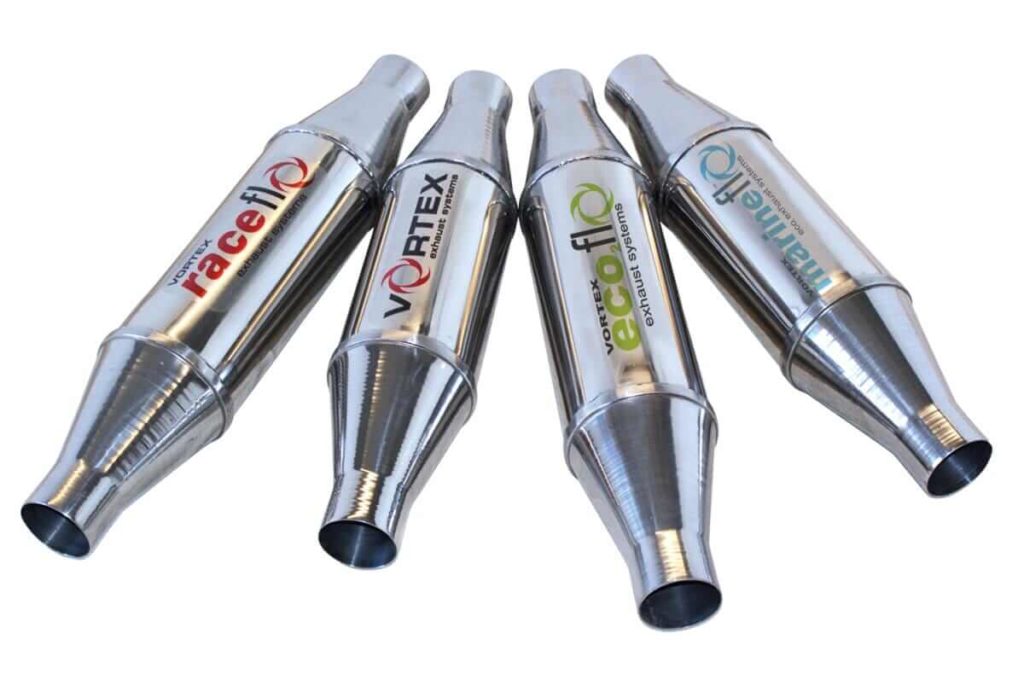Additional benefits include:
- Longer catalyst life
- Longer DPF life
- Increased service intervals
- Less carbon build up
- Longer engine life
- Improved heat dissipation
Vortex® patented Exhaust Technology improves engine efficiency, resulting in increased BHP and torque, reduced fuel consumption and significantly reduced harmful emissions.

Only one of the four engine cycles produce power, with the other three consuming power. Back pressure results in losses of 10 – 30% of engine efficiency and increased toxic emissions.
There are additional factors which add to back pressure build-up in an exhaust system including; catalytic converters, diesel particulate filters and silencers. These additional exhaust systems can reduce emissions and pulse waves but restrict the gas flow and cause backward pressure waves which all have a negative effect on engine efficiency.
This loss in efficiency results in:
Exhaust back pressure is a result of the engine’s inability to force toxic gases out of the combustion cylinder and away from the engine efficiently. Pulse waves, pressure waves and extremely hot gas, clashing with dense cool air, result in volatile conditions and temperatures of 800°C to 1100°C, causing a serious loss of engine
In the combustion chamber gas leak-back and back pressure causes:

Volumetric Efficiency
Vortex’s patented exhaust technology centres on improving Volumetric Efficiency (VE), which is the ability to move charge (air) into, and exhaust gas out of, the cylinders. VE is the key to greater engine efficiency, i.e. a more complete combustion, resulting in more power, lower emissions and improved MPG.
Closed loop self-educating ECUs adjust their parameters to ensure that a more complete combustion is taken advantage of. Consequently, tuners can take full advantage of air first and then fuel to achieve ultimate combustion. Furthermore, turbo-chargers operating in low back pressure environments lose their lag and rev to a higher velocity, significantly improving performance.
Traditional methods to reduce back pressure
All of the above achieve, at best, only minor varied improvements in reducing back pressure. However, with all these technologies the engine is still working hard to force the gas out of the system against the same amount of drag, therefore significant back pressure is still present.
Vortex’s patented exhaust technology uses wasted energy, in the form of exhaust pressure, to accelerate gas over a profiled shape, creating a vortex. Acceleration of the gas flow creates low pressure in front of the vortex, resulting in a vacuum effect. This low pressure allows the engine to evacuate exhaust gases efficiently in front of the vortex and acceleration of gas behind.
The effect of scavenging the exhaust gases in front of the vortex allows the engine to breathe freely with little or no gas leakage back in to the combustion chamber, allowing cleaner air into the cylinder for more complete combustion. The spiralling acceleration of gas out of the system ensures no further build-up of back pressure occurs, resulting in:
Additional benefits include:
Ever increasing legislation has forced vehicle manufacturers to reduce the emission of harmful by-products of fuel combustion. Consequently, exhaust systems have become more complex in their design and more restrictive to gas flow, thereby reducing vehicle performance and power.
Vortex products are unique and have created a new generation of custom exhaust technologies that improve volumetric efficiency, resulting in significant emissions reductions and improvements to fuel consumption and performance.
Importance of Vortex Technology to Reduce Toxic Emissions
It is widely accepted that we should all be seeking ways to minimise the emissions of internal combustion engines and the effects on people and the environment. Vortex Exhaust Technology provides a practical and significant solution to significantly reduce emissions.